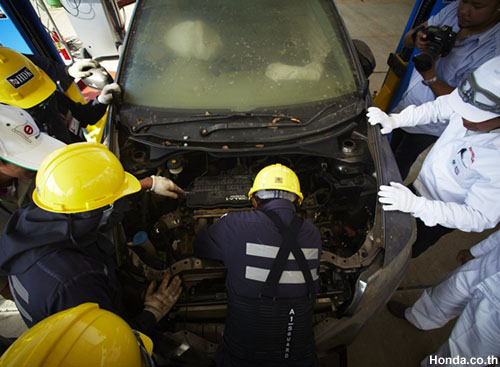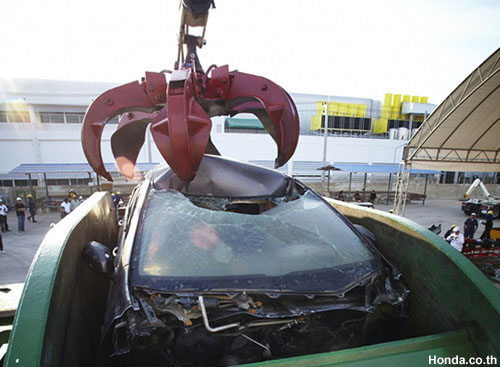Honda Thailand scrapped 1055 cars to convince its customers

Severe flooding happened in Thailand last year October has causes 1055 Honda cars to completely become scrap metal. These are brand new cars and sitting in Honda Thailand factory waiting for its new customers. Unfortunately, the flood water comes before the new customers. These cars cannot be sold because all of them had been sunken in flood waters and covered by mud. Honda tried to take action to save these remaining cars before the flood water comes but time is inadequate, resulting 1055 cars have to be the victim of the flood. Individual is able to save their car from flood but not Honda that has over one thousand cars sitting in the factory in Nikom Rojna industrial estate.
During end of December 2011, the flood situation eases after rain stops. Honda Thailand has to clean up the factory just like many other companies do. They have to clear these cars after they suffered a massive financial loss due to the factory being non-operational for several months. More than 60,000 units of vehicle could not be produced and now 1055 completed cars have to be cleared. We would have to say Honda did a great job in the scrapping process to prevent the cars from ever being sold. Every car is scrapped completely and become a piece of metal for recycle purpose.

There are six stations for the scrapping process. At first station and second station, brake fluid, transmission fluid, power steering fluid, engine oil, and coolant were completely drained. Air condition refrigerant is discharge too in order to protect the environment during the scrapping process.Battery, wheels, exhaust pipe, fuel tank, car hood, bumper, side mirrors, and engine were removed before the car send to scrapping zone. Plastic parts, dampers, radiator, condenser, wiring, spare tire, and transmission were removed at third and fourth station.

Basically, the body and all other parts are killed in the process to prevent it from being resold again including suspension, sub-frame, brake pump, fuel system, and engine. At fifth station, wheels were drilled with holes or damaged by Honda engineers with fire gun to avoid someone have them cleaned up and resold. Other components get destroyed in this station. All the recycle materials including battery, rubber, plastic, aluminium, steel, and metal go to the right place for recycle in the last station.
The most painful part of the process is the total value of these cars which has not revealed by Honda. There are 217 units of Honda Brio, 213 units of Honda Jazz, 353 units of Honda City, 150 units of Honda Civic, 91 units of Honda Accord, 30 units of Honda CR-V, and 1 unit of Honda Freed out of 1055 cars. Base onThailand market value for the cheapest model for all cars, it is approximately 417 million Thai baht (approximately 13 million USD as of January 2012).

Honda’s mission is to convince their customers to believe their quality in new vehicles. Cars and parts affected by flood will never be sold. The process is being done inRojanaIndustrial Parkunder the witness of media companies, Honda dealers, Ministry of Transport and Communications, and some other government agencies. Vehicle Identification Number (VIN) of every car is published atThailand’s Honda website. Source from Honda Thailand.
If you love this article, please PLUS it!
